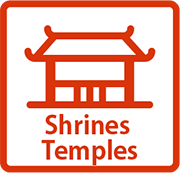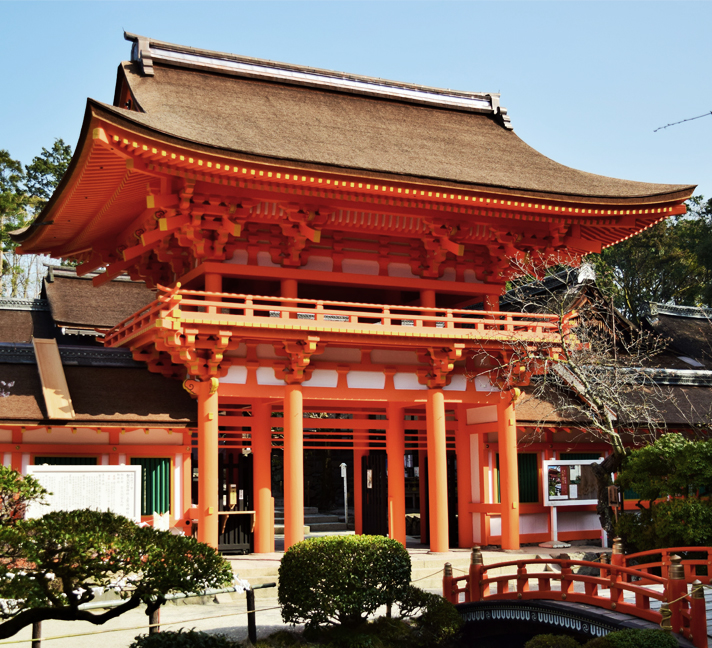
Kamo-wakeikazuchi Shrine (Kamigamo Shrine)
【History】
In the ancient times of the gods, there was a splendid mountain north-northwest of this shrine. The enshrined deity Kamo-wakeikazuchi descended upon Mount Koyama, and during the reign of Emperor Tenmu (678), the foundations of the current shrine building were laid. Even after the deity was enshrined at the main shrine, commoners from far and wide would pay their respects there, and successive generations of imperial households would do so as well. Emperors and Empresses would visit numerous times, and during times of grave importance to the country, they would always give offerings and make prayers there.
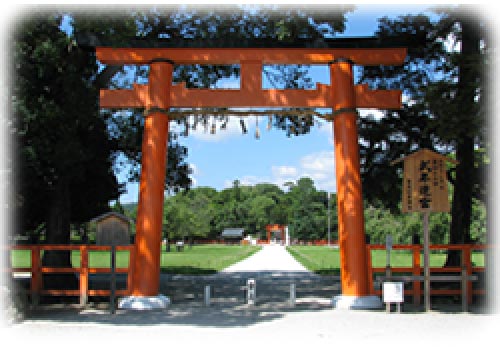
【Main building (structure) and shrine grounds】
Honden, where the enshrined deity is located, and the permanent structure of Gonden, which is the associate shrine, stand together on the east and west. They were both restored in 1863 (Bunkyu 3), and were designated as National Treasures in 1953 as classic examples of “nagare-style” architecture. The other shrine buildings were generally restored in 1628 (Kan’ei 5), and likewise most were designated as Important Cultural Properties in 1953, and the entire shrine grounds were registered as a UNESCO World Heritage Site in 1994 for the legacy left by the Heian period on them. In addition, sand cones representing Mount Koyama can be seen directly in front of you after passing through the second torii. Standing at their peaks are pine leaves, which make a pairing of light and darkness.
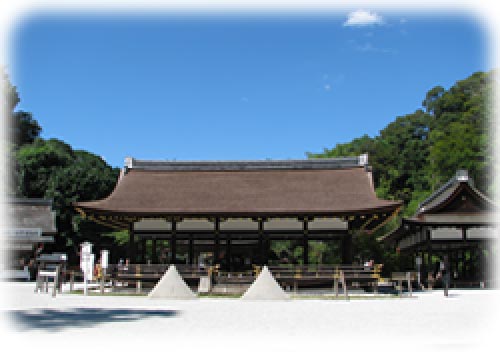
【Legend】
Kamigamo Shrine is said to be the oldest shrine in Kyoto, with a distant origin dating back over 2600 years ago.According to the legend of Kamo, when Kamo-tama-yori-hime-no-mikoto, a princess of the Kamo clan who moved to the ancient Yamashiro province (presently Kyoto city), was purifying her body in the river, a red lacquered arrow dropped from the heavens and floated to her from upstream.Kamo-tama-yori-hime-no-mikoto then brought the arrow home, venerated on the ground, and after she had rested, it is said that she received the divine power of the gods and was blessed with a son. During the son’s initiation into adulthood, Kamo-taketsu-numi-no-mikoto, who was his grandfather and the chief of the clan, invited many deities and held a celebratory feast. At his seat, his grandfather passed him a sake cup, saying, “To the deity who thinks of your father, I offer this cup to you.” The son replied, “My father is a deity in heaven,” and it was recorded that at the same time as a clap of thunder, he ascended to the heavens in that state. Kamo-tama-yori-hime-no-mikoto begged to be able to meet her son again, and her son appeared one night by her bedside, making the following oracle: “If you should wish to meet me, hang a bell on a horse and make it gallop, and make a wreath with hollyhock flowers and maple leaves; if you decorate yourself with it religiously and wait, I shall come.” It was said that when she followed those words, during a festival to welcome the gods, her son descended down from the heavens as a deity. That son who became a deity is known as Kamo-wakeikazuchi.
【Main festivals】
Annual festival – Kamo Festival (Hollyhock Festival or Aoi Matsuri) on May 15th
[Imperial festival – a festival to which an imperial envoy (messenger from the Emperor) is dispatched to]About 1400 years ago, a spell of storms and floods persisted, causing crops to be unable to ripen and the commoners to lament greatly. The then Emperor Kinmei ordered a divination to be done to investigate the cause, and it was ascertained to be a divine punishment by the great deity of Kamo. He then dispatched an envoy to hold a ceremonial festival at Kamo Shrine.Upon doing so, the winds and rains stopped, a bumper crop was produced, and peace reigned over the lands, thus making this the origin of the Kamo festival. From then on, it became held as a national event every year.This festival is so great that during the Heian period, when one mentioned the word “festival”, one would be referring to the Kamo Festival. As one of the three main festivals of Kyoto, it is held in the same manner as in the ancient times, with the imperial household sending an envoy to grace the festival even now.
On the day itself, not only the shrine buildings, but also all the people attending the festival are decorated with hollyhocks, thus giving the festival its familiar name of “Hollyhock Festival” ever since the festival procession was revived in the Edo period. The 800-meter long festival procession consists of 500 members in addition to ox carriages, flower umbrellas, and the Saio-dai (festival priestess) procession. Together with the solemn rituals performed at the shrine, watching the procession go down the city roads filled with new greenery is like looking at an elegant dynastic picture scroll.
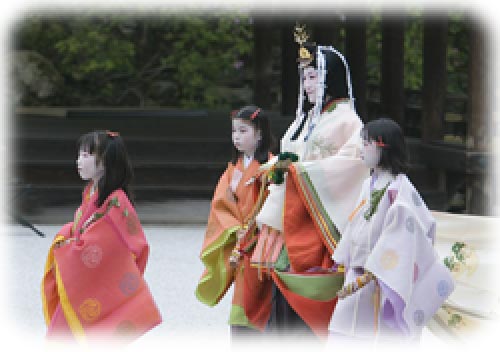
The Ritual of the Racehorses (Kamo-kurabe-uma) on May 5th
This ritual started during the Heian period when Emperor Horikawa offered horse races, as held in the imperial court, as a prayer for a bumper crop in 1093 (Kanji 7). The sight of the norijiri (=horsemen) racing to decide the winner in a tsugai (=head-to-head race), with one on the left and one on the right, is a truly magnificent spectacle which is also recorded in stories such as “Tsurezuregusa”.(Registered as an Intangible Folk Cultural Property under the city of Kyoto)
The Great Summer Purification Ritual on June 30th
This purification ritual is performed to rid oneself of the sins and impurities accumulated over the first half of the year. At 10am, the summer ritual begins at Honden, and at 8pm, bonfires are lit. As the shrine grounds are surrounded by darkness, human effigies made of paper are thrown into Nara River while the priests present the chant for the great purification ritual. In this manner, the sins and impurities of those who pray are cleansed and washed away.On December 31st, the great end-of-year purification ritual is held starting from 4pm.
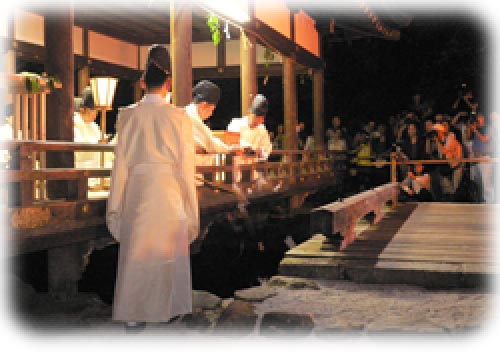
Double Ninth Festival and Karasu-zumo (Crow Sumo) on September 9th
September 9th is considered to be an auspicious day where two yang numbers (double nines) occur, so festivals have been held since ancient times to pray for longevity. On the day itself, chrysanthemums are offered at the altar as part of the Double Ninth Festival to pray for longevity. This continues with sumo matches by children in an arena constructed in front of the sand cones, which the Saio-dai (festival priestess) who attended the Hollyhock Festival views from within the “Hosodono”, located behind the sand cones. (Registered as an Intangible Folk Cultural Property under the city of Kyoto)
| Benefits: | For warding off evil, protection against lightning, electronics businesses |
|---|---|
| Access: | 5-minute walk from Misonobashi801 Shopping Center. Short distance upon alighting at “Kamigamo-jinja-mae” from the City Bus/Kyoto Bus About 5 minutes by car from the “Kitaoji” and “Kitayama” subway stationsA |
| Fee: | Free to visit |





